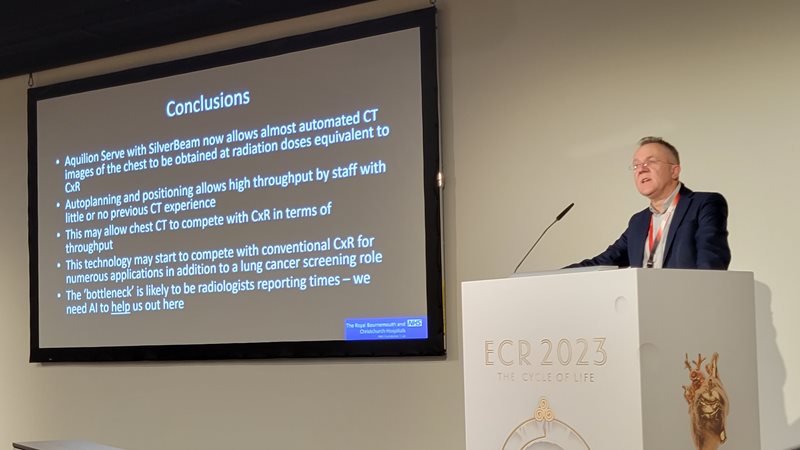New Technologies Drop Dose for CT Lung Cancer Screening
 New radiation dose reduction technologies for CT are proving to be so successful that they are able to lower CT dose to the level of a chest x-ray. That could be a game-changer when it comes to CT lung cancer screening, according to a presentation at the European Congress of Radiology (ECR) 2023.
New radiation dose reduction technologies for CT are proving to be so successful that they are able to lower CT dose to the level of a chest x-ray. That could be a game-changer when it comes to CT lung cancer screening, according to a presentation at the European Congress of Radiology (ECR) 2023.
CT is an almost perfect medical imaging modality, according to Dr. Russell Bull of Royal Bournemouth Hospital in the U.K. It is fast, available in many hospitals, and is an excellent tool for detecting multiple pathologies.
CT’s main limiting factor is radiation dose relative to x-ray, Bull said. But what if you could reduce the difference in radiation dose between CT and x-ray, while automating the scanning process at the same time?
That’s becoming a reality with new technologies that were on display at ECR 2023. One of these is beam filtration using SilverBeam, a beam-shaping energy filter introduced in the last few years by Canon Medical Systems.
SilverBeam employs solid silver wedge filtration that filters out almost all low-energy photons in the x-ray beam. This produces a beam that is very high energy at almost a single energy level. The technology holds the potential for very low CT radiation dose for noncontrast studies (the technique is not suitable for contrast-based exams), Bull said.
SilverBeam has been in use at Royal Bournemouth Hospital for the past three years on a Canon Aquilion Genesis scanner, and Canon has introduced the technology on other scanners, including the Aquilion Prism and Aquilion Serve systems. The latter scanner was introduced at ECR 2023.
In his ECR talk, Bull demonstrated a variety of images acquired with SilverBeam at doses equivalent to chest x-rays. What’s more, the technology has the potential to enable scanograms – the extremely low-dose CT scans performed to set the imaging parameters of the main scan – to acquire diagnostic-quality images.
For example, with SilverBeam a CT scanner can acquire 3D scanograms that are of good enough quality to reveal pathology. Radiologists could take the 3D scanogram from a cardiac CT study and use it for lung cancer screening, for example, Bull said.
The launch of Aquilion Serve at ECR 2023 takes SilverBeam to a new level, as the scanner was designed from the ground up to make full use of the technology, Bull said. In his ECR talk, Bull demonstrated chest images acquired at radiation doses with a dose-length product (DLP) of 15 mGy*cm, or less than 0.3 mSv. Chest x-rays are in the range of 0.1 mSv.
Aquilion Serve also includes automation features designed to make CT scans easier to set up and interpret, with one-button patient positioning, for example. The scanner has two cameras embedded within the gantry that can be used to center the patient in up/down and right/left positions.
What’s more, Aquilion Serve includes technologies like Canon’s new INSTINX workflow solution that’s designed to improve workflow in CT scanning, eliminating some of the complexities that make CT scans harder to perform and report than x-ray.
SilverBeam does have limitations. While it’s highly suited for chest x-rays, it’s less appropriate for contrast studies or for applications like brain scans.
Also, reporting bottlenecks may occur as radiologists learn to manage the higher volume of studies that are now possible. Artificial intelligence (AI) could help in this respect, Bull said.
But Bull concluded by stating that he believes that dose-reduction technologies like SilverBeam and automation tools found on Aquilion Serve could convince many radiologists to switch to CT.
“Are automated scans with SilverBeam the end of the chest x-ray?” Bull asked. “I think they are, actually. If I was a patient, which would I rather have? These are pretty much the same radiation dose.”
Citation
New Technologies Drop Dose for CT Lung Cancer Screening. Appl Radiol.
March 21, 2023